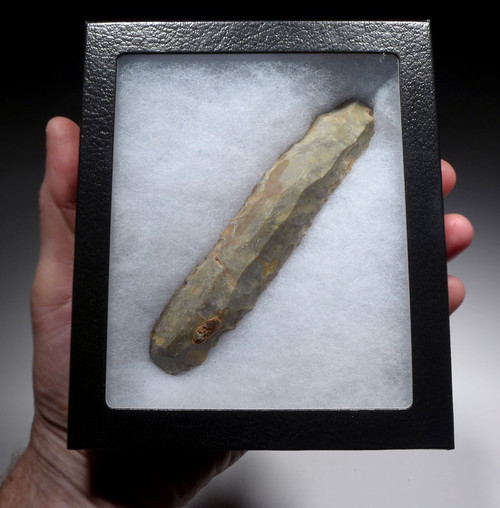Product Description
SEE MORE AFRICAN NEOLITHIC BEAD AND JEWELRY ARTIFACTS
This AFRICAN CAPSIAN NEOLITHIC artifact was found on an exposed northwest African Neolithic site in the Sahara Desert. It was fashioned by ancient man (Homo sapiens sapiens) between 10,000 and 4,700 years ago.
Carved and polished out of hardstone, this unbroken doughnut bead is RARE to have survived as made. Furthermore, the amazing wear grooves on the surface show how long it was worn and by what method it was suspended on a cord as a pendant. Compared to ordinary beads in which many made up a necklace, main feature pendants like these were often worn alone and are much more rare to find. This exceptionally fine example shows excellent workmanship. Do not be fooled by its size,. To make a carved stone bead in this form in ancient times would have taken an extraordinary amout of time and skill. This pendant is complete as originally made with all the important traits of age and authenticity - intact mineral deposits deep in microscopic crevices. Beware of modern forgeries lacking these features, or later Colonial trade beads being sold as "Neolithic". Both dominate the market! Authentic Neolithic stone pendants like these are very scarce.
This is a classic artifact of African Capsian Neolithic body adornment and ornamentation. Beads and pendants were part of the main personal decoration of a Neolithic man or woman over 5000 years ago in Africa. Completely durable and safe to wear for another 5000 years! Archaeological sites of the African Neolithic yield some jewelry items and give us a glimpse of what body ornamentation and personal adornment looked like back in this period long ago. Beads, lip plugs and bracelets are sometimes found. Tools and weapons were an item of necessity but body jewelry reveals to us another side of the mind of primitive and ancient Man that the other artifacts do not give us. Perfect to display alongside similar period tools and weapons to illustrate the larger picture of life in this time!
 US DOLLAR
US DOLLAR
 EURO
EURO
 AUSTRALIAN DOLLAR
AUSTRALIAN DOLLAR
 CANADIAN DOLLAR
CANADIAN DOLLAR
 POUND STERLING
POUND STERLING














